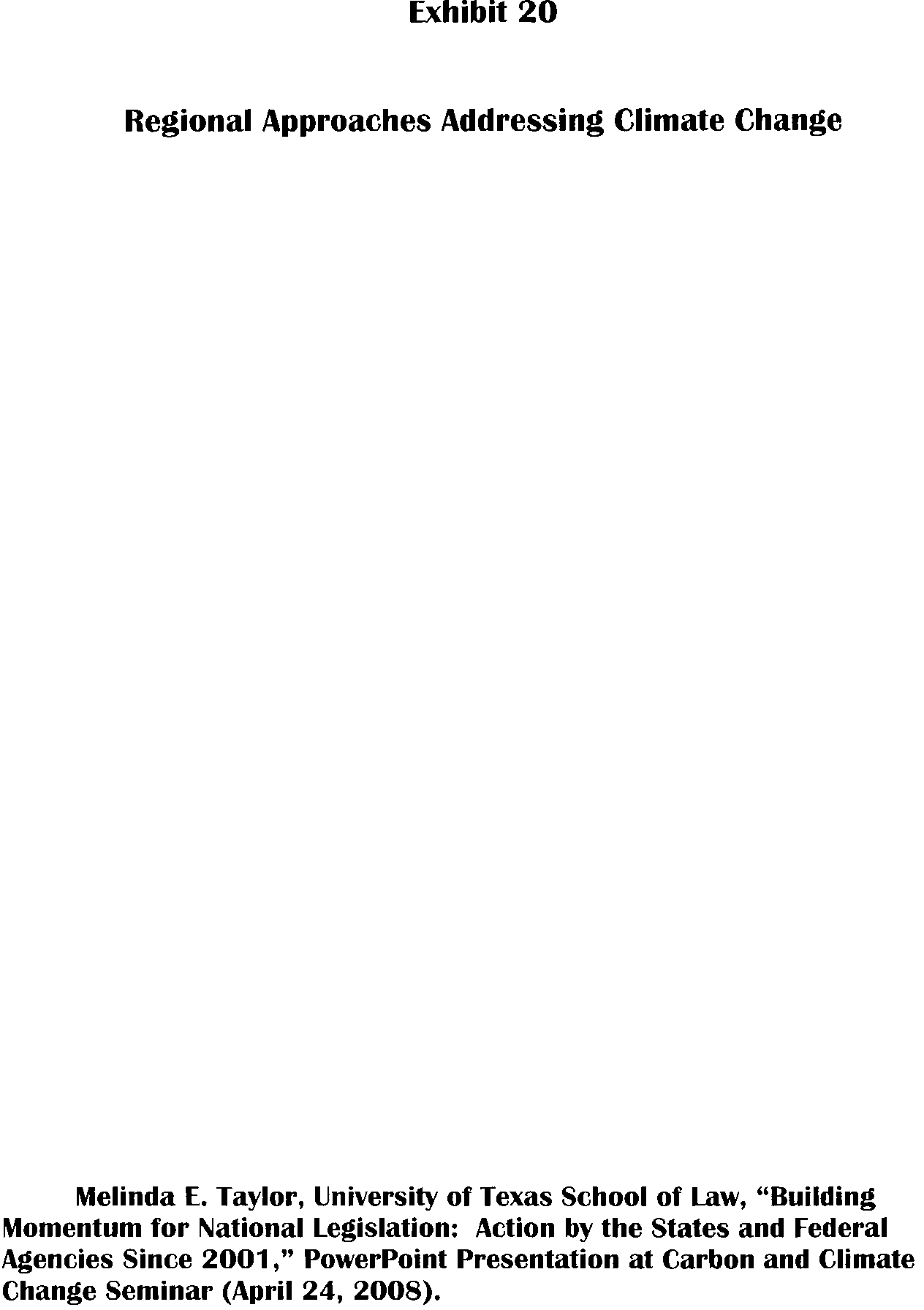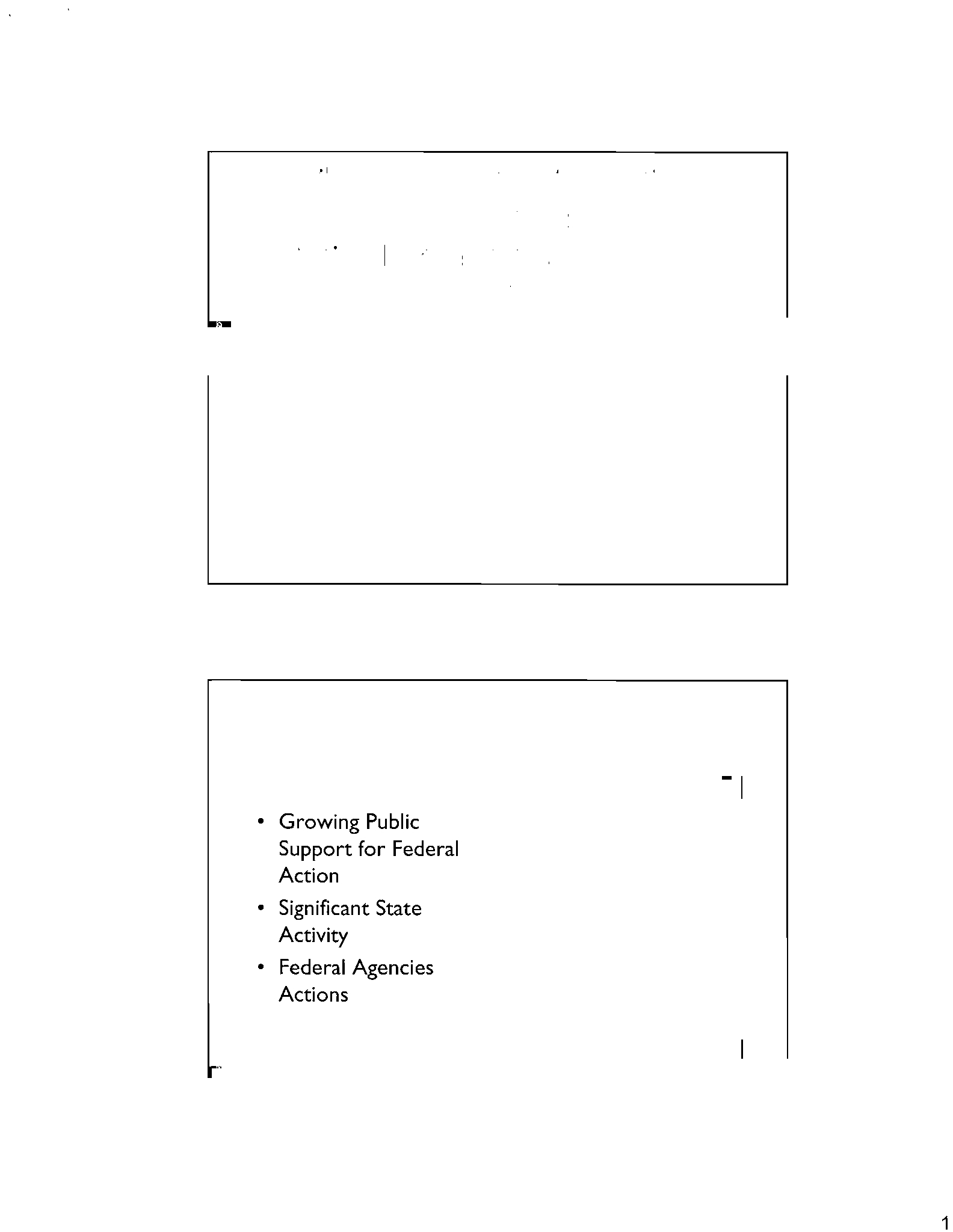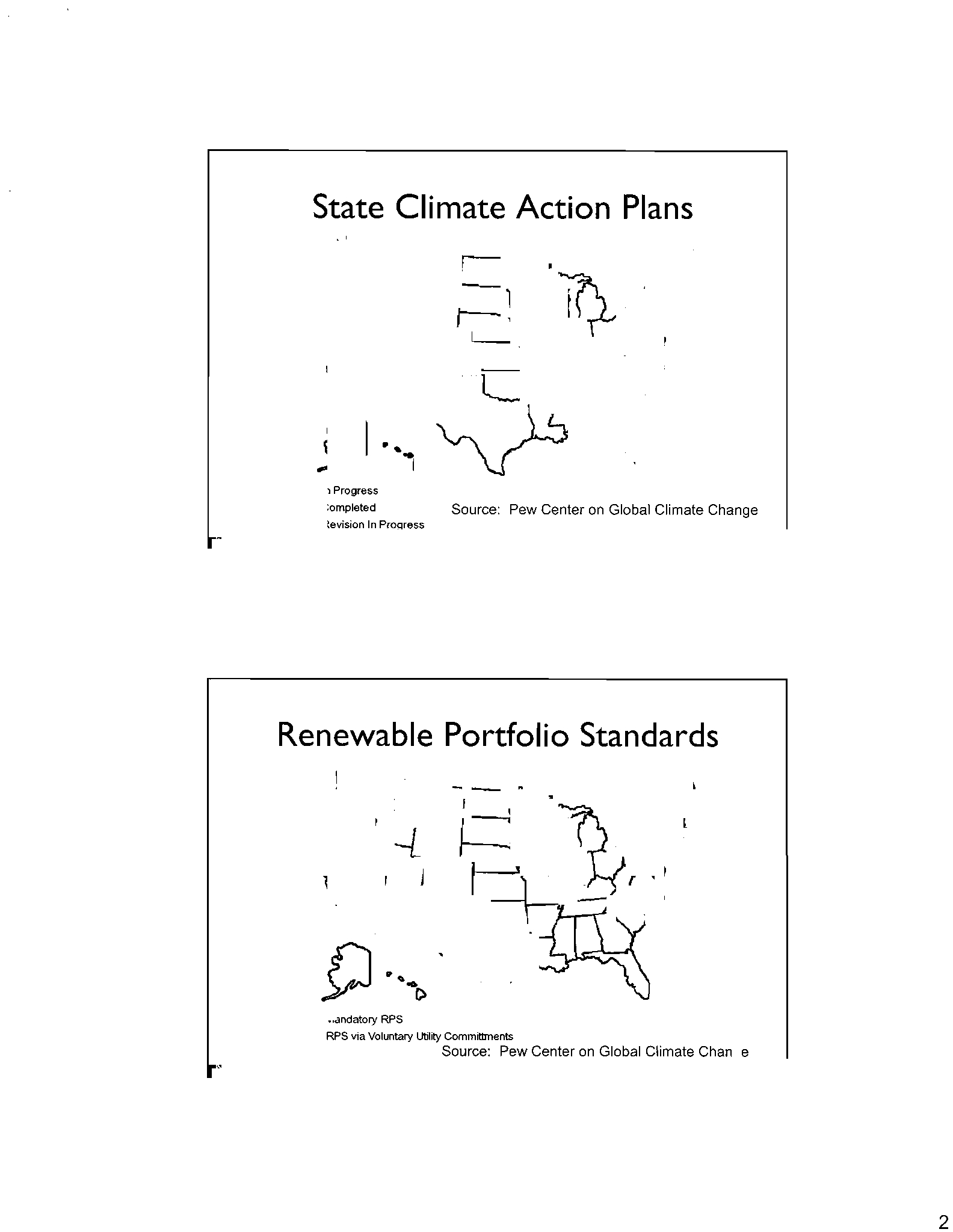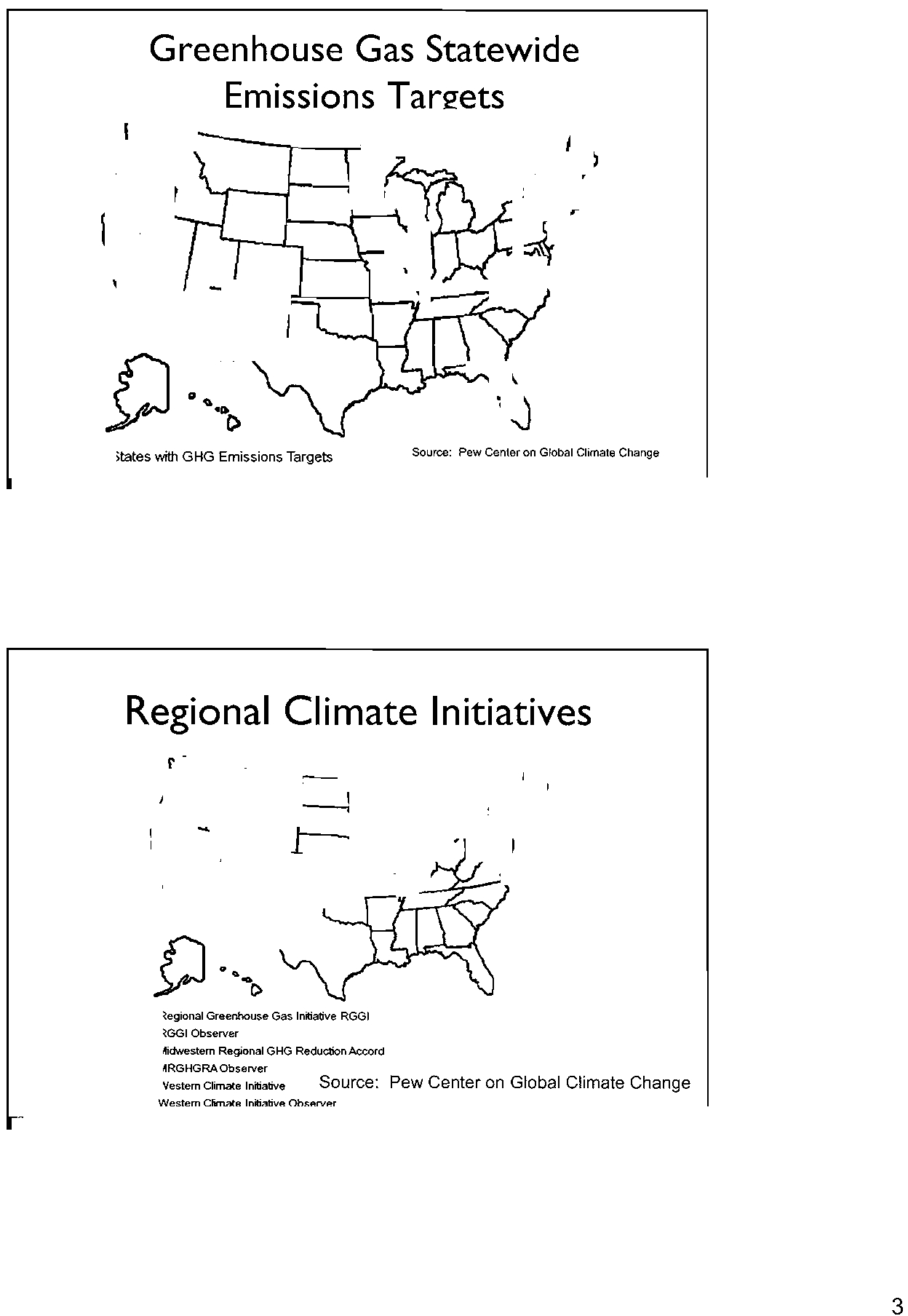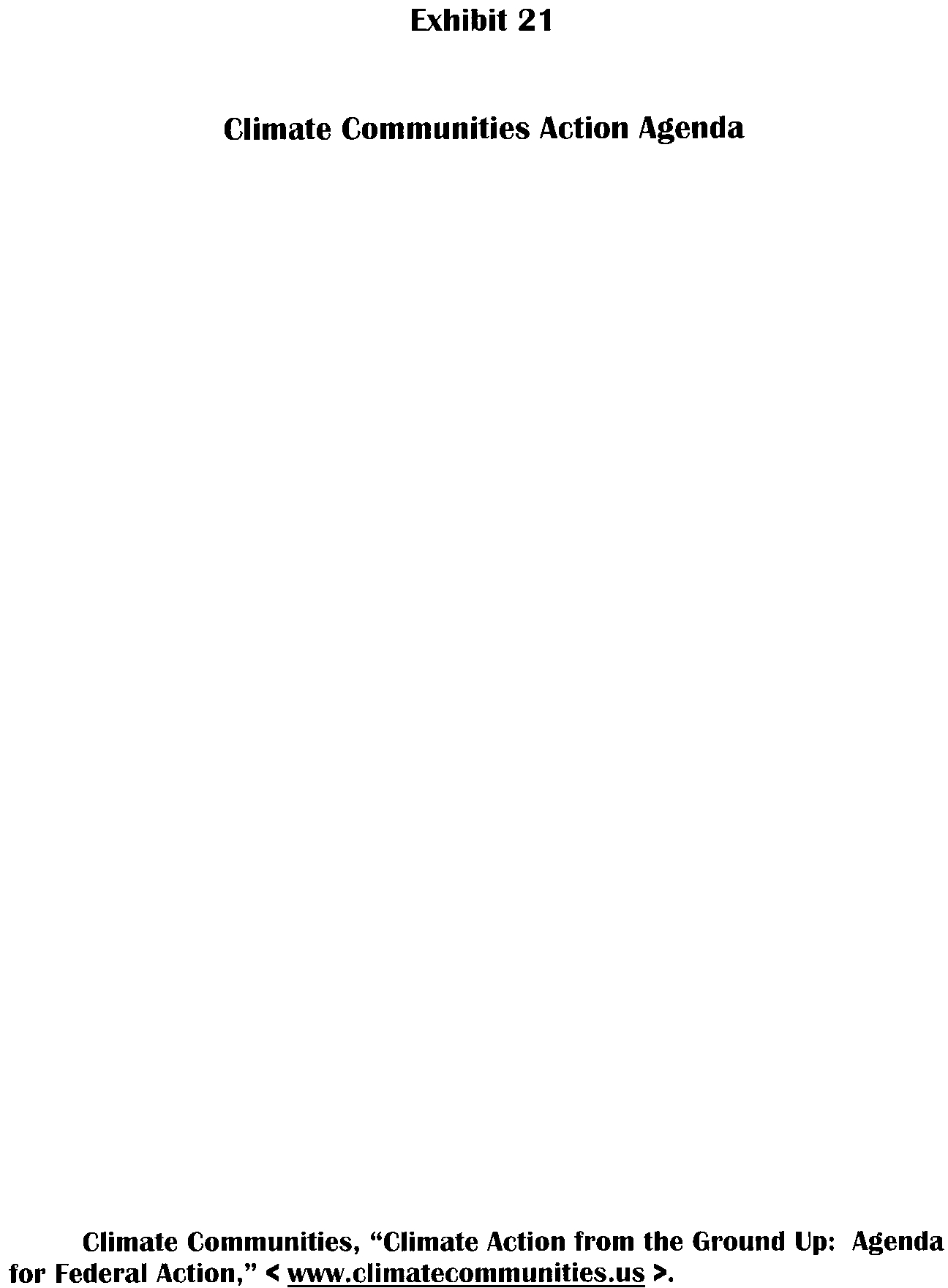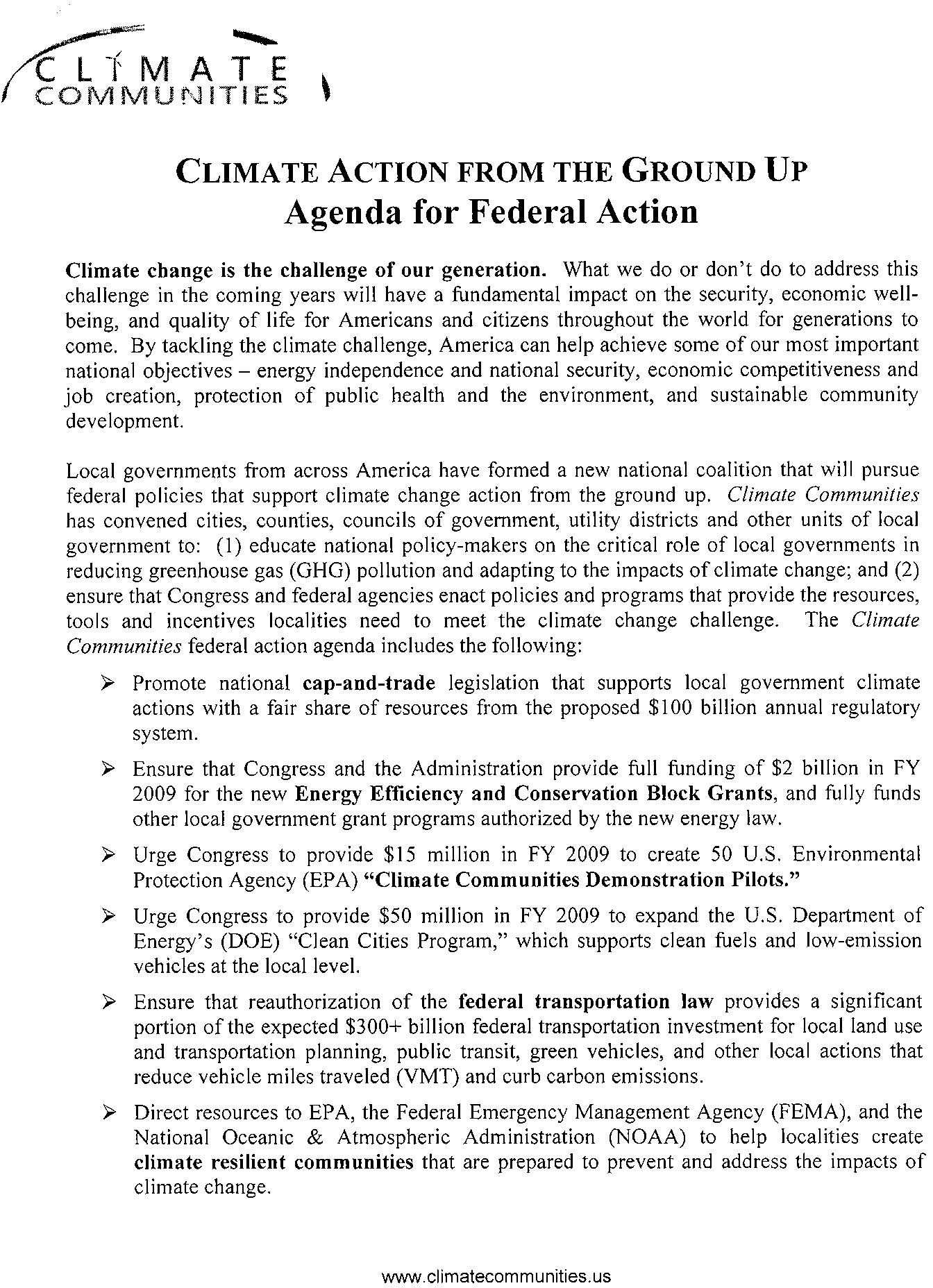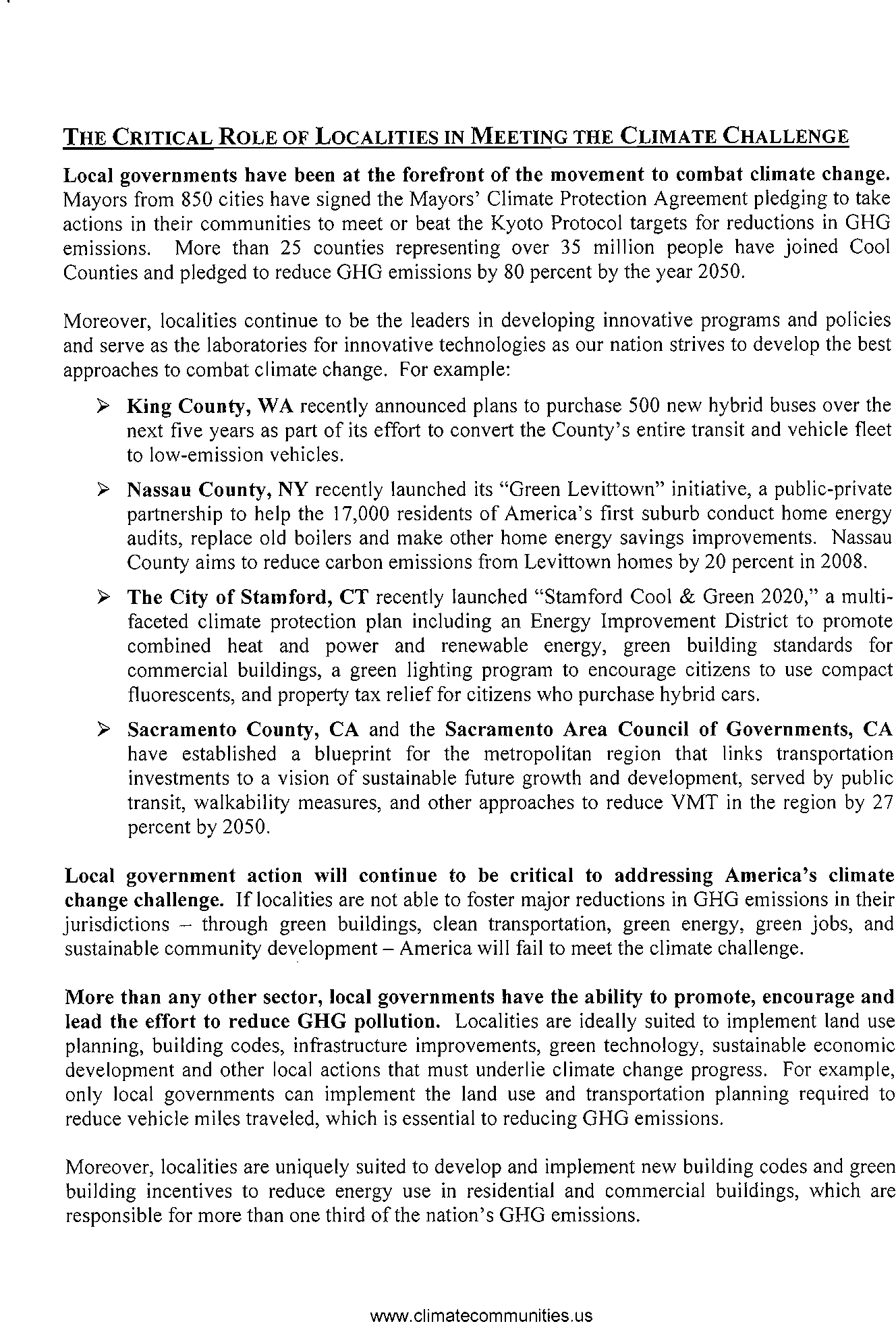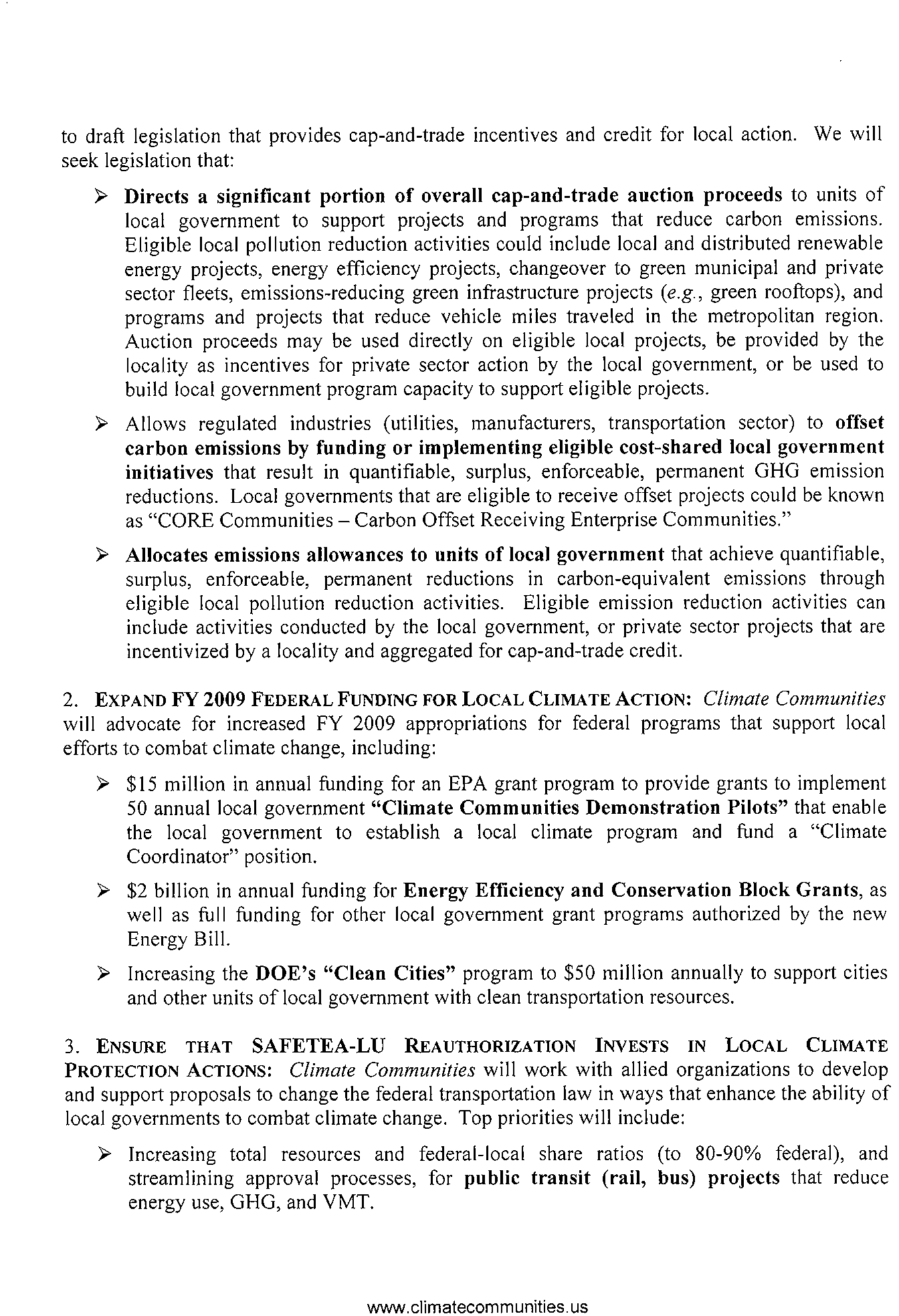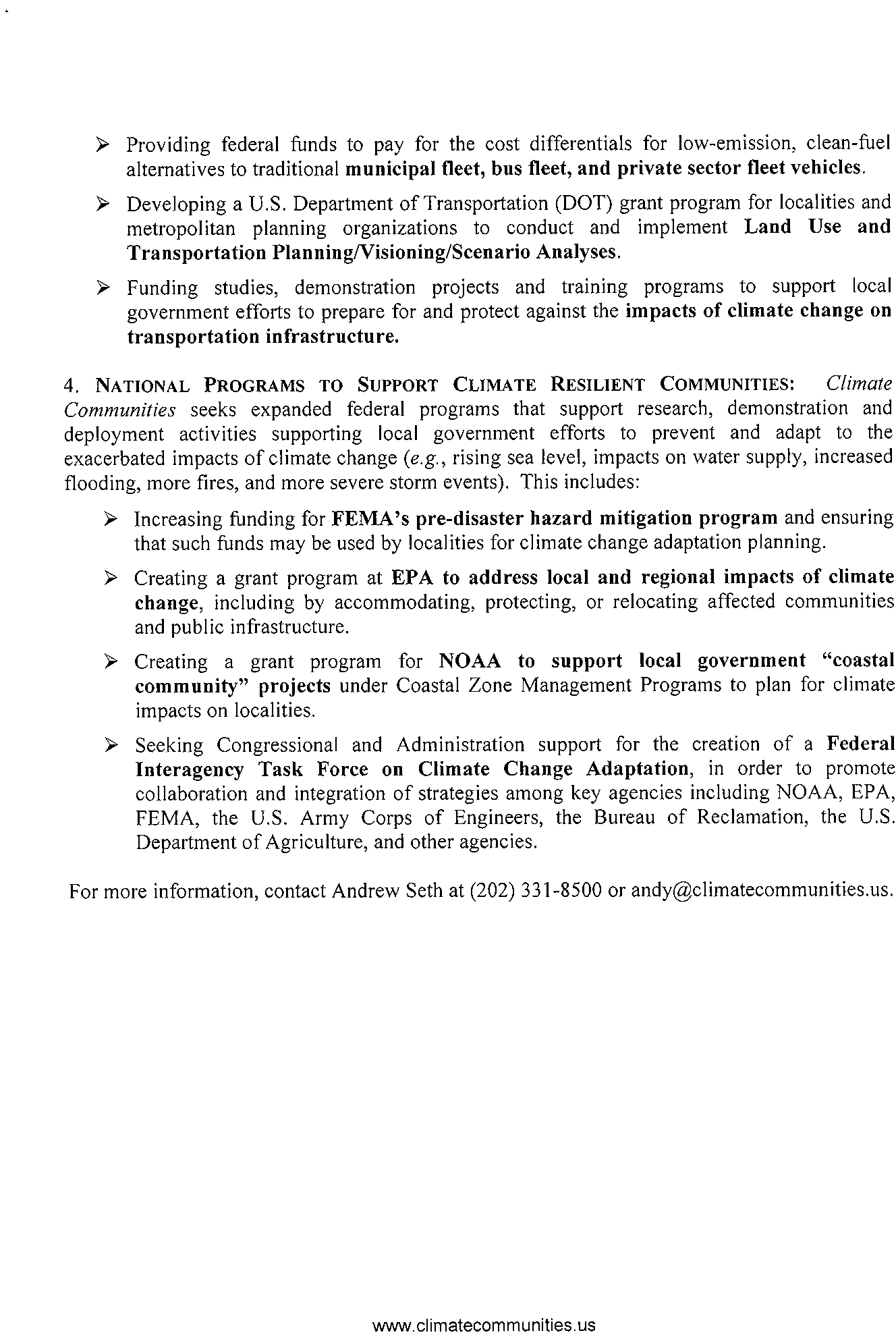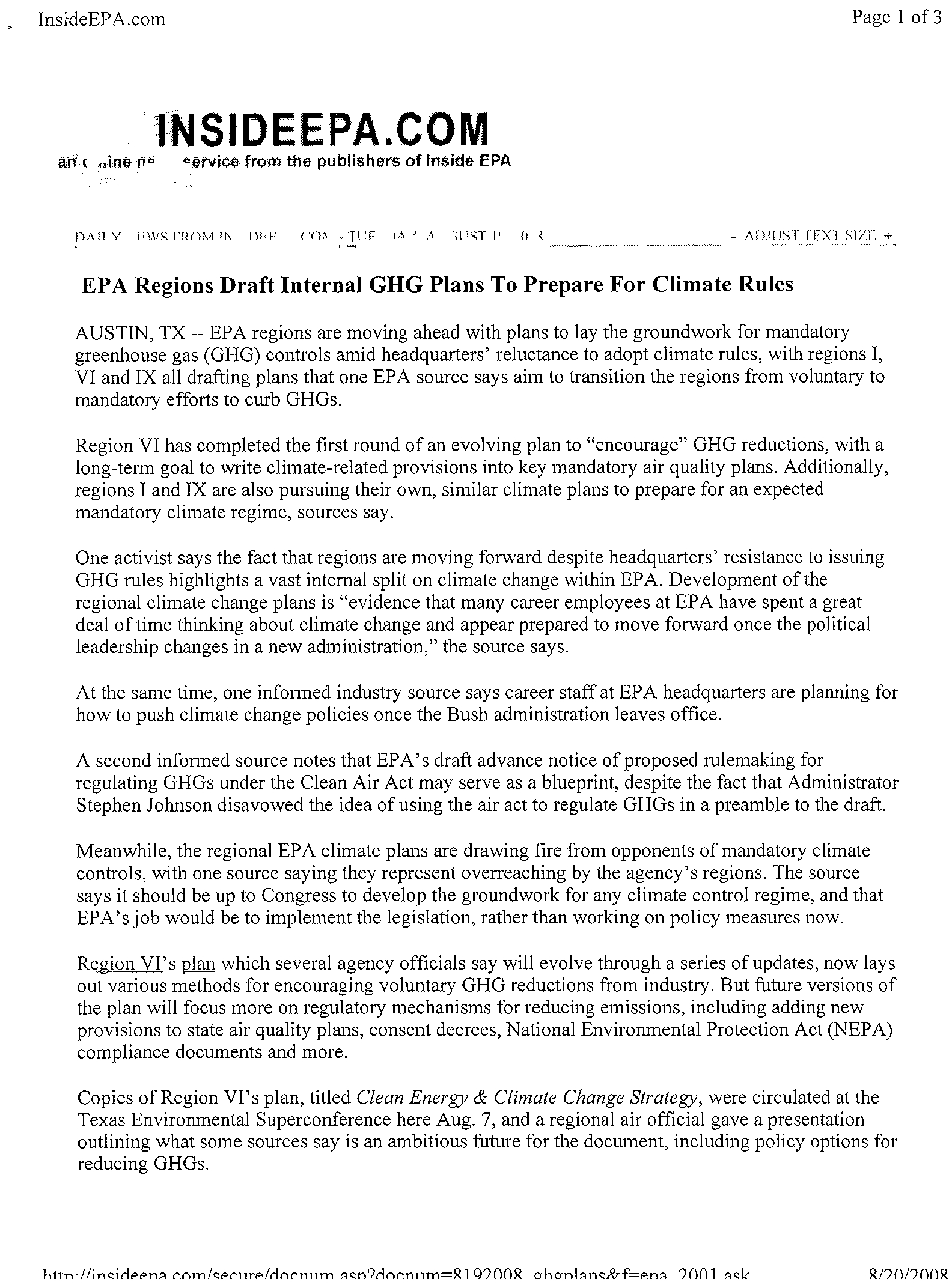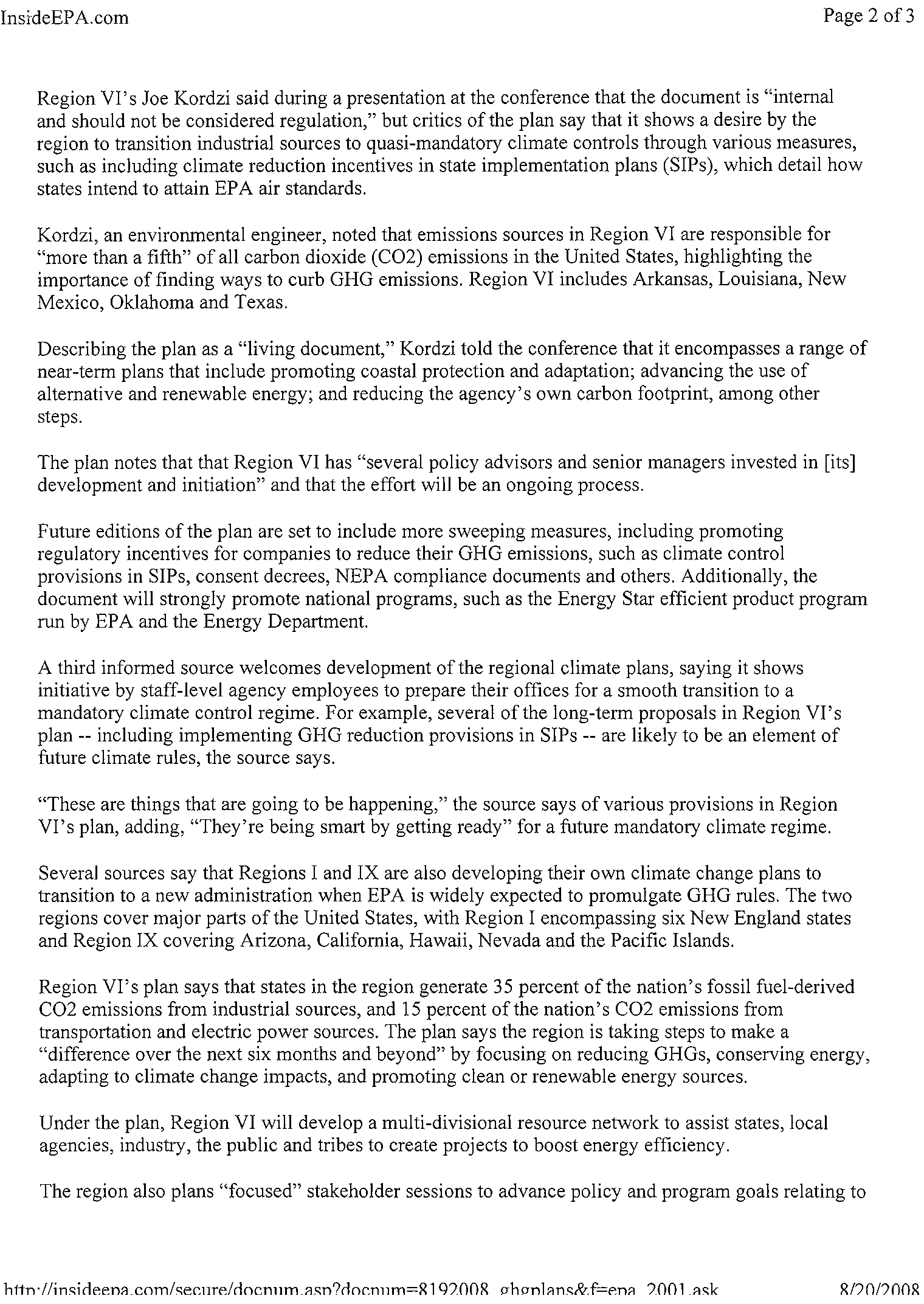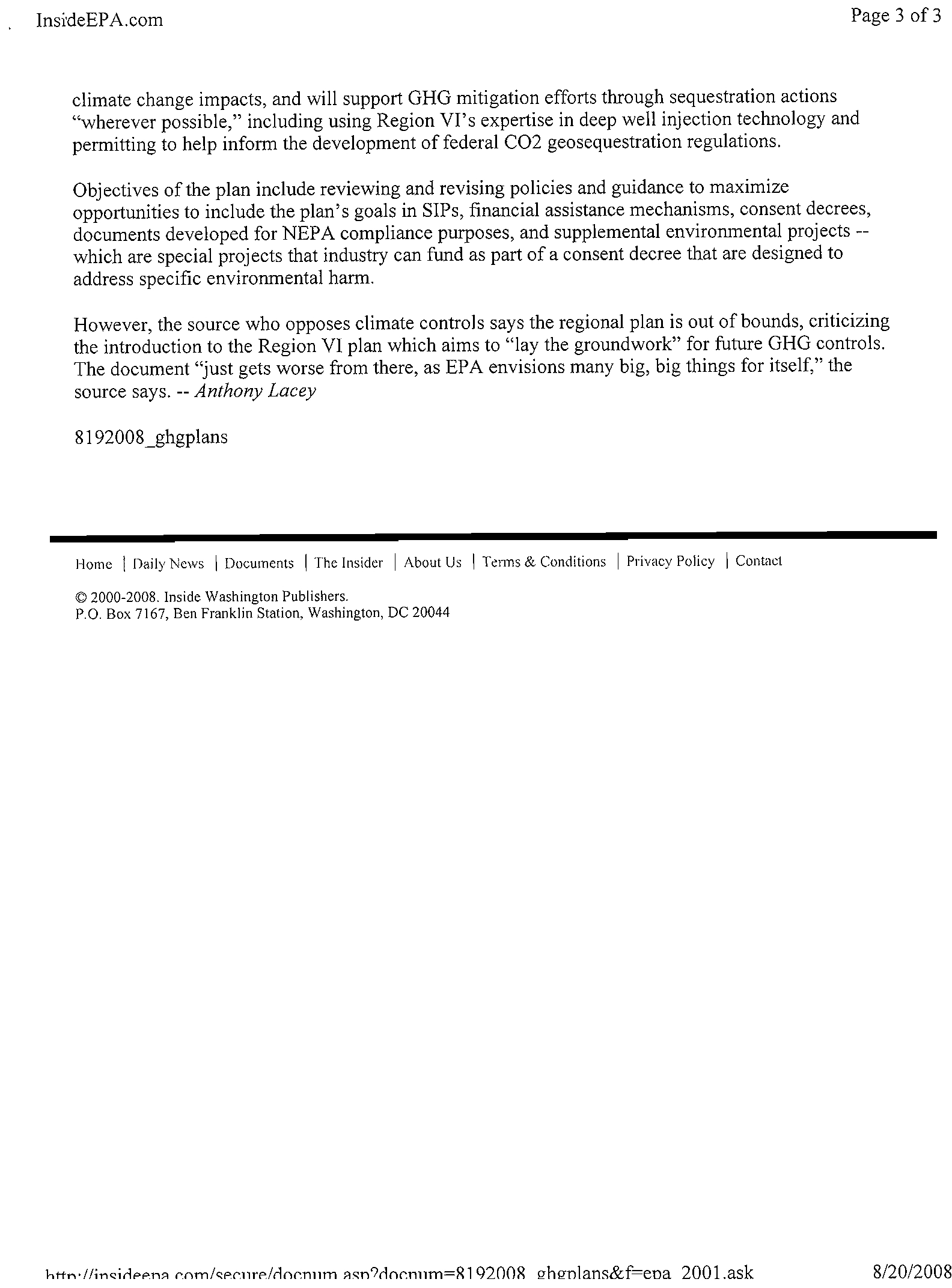Melinda
E.
Taylor,
University
of
Texas
School
of
law,
"Building
Momentum
for
National
Legislation:
Action
by
the
States
and
Federal
Agencies
Since
2001,"
PowerPoint
Presentation
at
Carbon
and
Climate
Change
Seminar
(April
24,
2008).
Electronic Filing - Received, Clerk's Office, October 1, 2008
* * * * * PCB 2009-021 * * * * *
Action
by
the
States
and
Federal
Agencies
Back to top
Since
200
I
,
'"'
""'VIR'''t
'"
TlU\
AI"""''''
SCHOOL
OF
LAW
Melinda
E.
Taylor
Clinical
Professor
of
Law
Outline
•
Growing
Public
Support
for
Federal
Action
•
Significant
State
Activity
•
Federal
Agencies
Actions
Iitl
U"I\II('II\
",
"x
..
,
AJ
"""'"
SCHOOL
OF
LAW
1
Electronic Filing - Received, Clerk's Office, October 1, 2008
* * * * * PCB 2009-021 * * * * *
n".
.Y-J
....
•
In
Progress
.Completed
Source:
Pew
Center
on
Global
Climate
Change
•
Revision
In
Progress
•
TIl!
1I"IVIIl'lIYOIIIXA'A1AlIHI"
SCHOOL
OF
LAW
Renewable
Portfolio
Standards
•
Mandatory
RPS
RPS
via
Voluntary
Utility
Committments
Source:
Pew
Center
on
Global
Climate
Change
till
U"IVIR,I1Y<ll
11);:
..
'
.or
"1,.11"
SCHOOL
OF
LAW
2
Electronic Filing - Received, Clerk's Office, October 1, 2008
* * * * * PCB 2009-021 * * * * *
n
"
..
Y
""I>
•
States
with
GHG
Emissions
Targets
Ilil
UslVlllSlIY
ur
lIXA'
AI
"llSIl"
SCHOOL
OF
LAW
Source:
Pew
Center
on
Global
Climate
Change
Regional
Climate
Initiatives
•
Regional
Greenhoose
Gas
Initiative
RGGI
•
ROOI
Observer
.Midwestern
Regional
GHG
RedoctionAccord
MRGHGRAObS91'Vef
.Western
Climate
lnitiative
Source:
Pew
Center
on
Global
Climate
Change
•
Western
amate
lniti<Jtive
Observer
till
u
..
rVIIl'll
Y
01
I
IX
...
,AI
At
")0;
SCHOOL
OF
LAW
3
Electronic Filing - Received, Clerk's Office, October 1, 2008
* * * * * PCB 2009-021 * * * * *
•
EIS
required
for
"major
Federal
actions"
•
Court
challenges
for
failure
to
address
GHG
emissions
in
EIS.
forest
plans.
federal
funding
decisions
Illi
U-.JrVlll.SI
TY
<11
l1X'"
",
""1111<
SCHOOL
or
LAW
Endangered
Species
Act
•
Listing
Decisions
•
Designation
of
Critical
Habitat
•
Consultation
Requirement
•
Prohibition
on
"Take"
•
Incidental
Take
Authorization
Photo
Credit:
USFWS
IHI
Uo,;'\IR"n
III
T1X"'\
AT
AI
lIlI<
SCHOOL
or
LAW
4
Electronic Filing - Received, Clerk's Office, October 1, 2008
* * * * * PCB 2009-021 * * * * *
•
High
likelihood
of
federal
law
in
near
future
•
States
have
taken
action
to
address
emissions
from
electricity
generating
sector,
mobile
sources,
agriculture
•
Federal
agencies
are
incorporating
analyses
of
climate
change
impacts
into
NEPA
documents
and
endangered
species
decisions
,
Tttl
no,JlVIRSllYUI
11X~'''1
"U\IIN
SCHOOL
OF
LAW
5
Electronic Filing - Received, Clerk's Office, October 1, 2008
* * * * * PCB 2009-021 * * * * *
Climate
Communities,
"Climate
Action
from
the
Ground
Up:
Agenda
for
Federal
Action,"
<
www.climatecommunities.us
>.
Electronic Filing - Received, Clerk's Office, October 1, 2008
* * * * * PCB 2009-021 * * * * *
Agenda
for
Federal
Action
Climate
change
is
the
challenge
of
our
generation.
What
we
do
or
don't
do
to
address
this
challenge
in
the
coming
years
will
have
a
fundamental
impact
on
the
security,
economic
well-
being,
and
quality
of
life
for
Americans
and
citizens
throughout
the
world
for
generations
to
come.
By
tackling
the
climate
challenge,
America
can
help
achieve
some
of
our
most
important
national
objectives
-
energy
independence
and
national
security,
economic
competitiveness
and
job
creation,
protection
of
public
health
and
the
environment,
and
sustainable
community
development.
Local
governments
from
across
America
have
formed
a
new
national
coalition
that
will
pursue
federal
policies
that
support
climate
change
action
from
the
ground
up.
Climate
Communities
has
convened
cities,
counties,
councils
of
government,
utility
districts
and
other
units
of
local
government
to:
(I)
educate
national
policy-makers
on
the
critical
role
of
local
governments
in
reducing
greenhouse
gas
(OHO)
pollution
and
adapting
to
the
impacts
of
climate
change;
and
(2)
ensure
that
Congress
and
federal
agencies
enact
policies
and
programs
that
provide
the
resources,
tools
and
incentives
localities
need
to
meet
the
climate
change
challenge.
The
Climate
Communities
federal
action
agenda
includes
the
following:
>-
Promote
national
cap-and-trade
legislation
that
supports
local
government
climate
actions
with
a
fair
share
of
resources
from
the
proposed
$100
billion
annual
regulatory
system.
>-
Ensure
that
Congress
and
the
Administration
provide
full
funding
of
$2
billion
in
FY
2009
for
the
new
Energy
Efficiency
and
Conservation
Block
Grants,
and
fully
funds
other
local
government
grant
programs
authorized
by
the
new
energy
law.
>-
Urge
Congress
to
provide
$15
million
in
FY
2009
to
create
50
U.S.
Environmental
Protection
Agency
(EPA)
"Climate
Communities
Demonstration
Pilots."
>-
Urge
Congress
to
provide
$50
million
in
FY
2009
to
expand
the
U.S.
Department
of
Energy's
(DOE)
"Clean
Cities
Program,"
which
supports
clean
fuels
and
low-emission
vehicles
at
the
local
level.
>-
Ensure
that
reauthorization
of
the
federal
transportation
law
provides
a
significant
portion
of
the
expected
$300+
billion
federal
transportation
investment
for
local
land
use
and
transportation
planning,
public
transit,
green
vehicles,
and
other
local
actions
that
reduce
vehicle
miles
traveled
(VMT)
and
curb
carbon
emissions.
>-
Direct
resources
to
EPA,
the
Federal
Emergency
Management
Agency
(FEMA),
and
the
National
Oceanic
&
Atmospheric
Administration
(NOAA)
to
help
localities
create
climate
resilient
communities
that
are
prepared
to
prevent
and
address
the
impacts
of
climate
change.
WWIN.climatecommunities.us
Electronic Filing - Received, Clerk's Office, October 1, 2008
* * * * * PCB 2009-021 * * * * *
Counties
and
pledged
to
reduce
GHG
emissions
by
80
percent
by
the
year
2050.
Moreover,
localities
continue
to
be
the
leaders
in
developing
innovative
programs
and
policies
and
serve
as
the
laboratories
for
innovative
technologies
as
our
nation
strives
to
develop
the
best
approaches
to
combat
climate
change.
For
example:
~
King
County,
WA
recently
announced
plans
to
purchase
500
new
hybrid
buses
over
the
next
five
years
as
part
of
its
effort
to
convert
the
County's
entire
transit
and
vehicle
fleet
to
low-emission
vehicles.
~
Nassau
County,
NY
recently
launched
its
"Green
Levittown"
initiative,
a
public-private
partnership
to
help
the
17,000
residents
of
America's
first
suburb
conduct
home
energy
audits,
replace
old
boilers
and
make
other
home
energy
savings
improvements.
Nassau
County
aims
to
reduce
carbon
emissions
from
Levittown
homes
by
20
percent
in
2008.
~
The
City
of
Stamford,
CT
recently
launched
"Stamford
Cool
&
Green
2020,"
a
multi-
faceted
climate
protection
plan
including
an
Energy
Improvement
District
to
promote
combined
heat
and
power
and
renewable
energy,
green
building
standards
for
commercial
buildings,
a
green
lighting
program
to
encourage
citizens
to
use
compact
fluorescents,
and
property
tax
relief
for
citizens
who
purchase
hybrid
cars.
~
Sacramento
County,
CA
and
the
Sacramento
Area
Council
of
Governments,
CA
have
established
a
blueprint
for
the
metropolitan
region
that
links
transportation
investments
to
a
vision
of
sustainable
future
growth
and
development,
served
by
public
transit,
walkability
measures,
and
other
approaches
to
reduce
YMT
in
the
region
by
27
percent
by
2050.
Local
government
action
will
continue
to
be
critical
to
addressing
America's
climate
change
challenge.
If
localities
are
not
able
to
foster
major
reductions
in
GHG
emissions
in
their
jurisdictions
-
through
green
buildings,
clean
transportation,
green
energy,
green
jobs,
and
sustainable
community
development
-
America
will
fail
to
meet
the
climate
challenge.
More
than
any
other
sector,
local
governments
have
the
ability
to
promote,
encourage
and
lead
the
effort
to
reduce
GHG
pollution.
Localities
are
ideally
suited
to
implement
land
use
planning,
building
codes,
infrastructure
improvements,
green
technology,
sustainable
economic
development
and
other
local
actions
that
must
underlie
climate
change
progress.
For
example,
only
local
governments
can
implement
the
land
use
and
transportation
planning
required
to
reduce
vehicle
miles
traveled,
which
is
essential
to
reducing
GHG
emissions.
Moreover,
localities
are
uniquely
suited
to
develop
and
implement
new
building
codes
and
green
building
incentives
to
reduce
energy
use
in
residential
and
commercial
buildings,
which
are
responsible
for
more
than
one
third
of
the
nation's
GHG
emissions.
www.climatecommunities.us
Electronic Filing - Received, Clerk's Office, October 1, 2008
* * * * * PCB 2009-021 * * * * *
A
STRONG
LOCAL-FEDERAL
PARTNERSHIP
IS
ESSENTIAL
TO
ADDRESSING
CLIMATE
CHANGE
While
local
governments
are
uniquely
suited
to
playa
leadership
role
in
addressing
climate
change,
a
strong
partnership
with
the
federal
government
is
essential.
Like
homeland
security,
addressing
climate
change
will
require
a
national
response
and
commitment.
Whilemany
localities
have
pledged
action
to
prevent
and
adapt
to
climate
change,
most
are
just
beginning
to
develop
their
climate
protection
plans.
In
order
to
turn
local
climate
pledges
into
real
action,
localities
need
funding,
incentives,
and
other
assistance
from
the
federal
government.
However,
despite
thecritical
role
of
local
governments
in
meeting
the
climate
challenge,
the
federal
government
currently
provides
very
little
funding
or
assistance
to
help
localities
develop
local
climate
protection
strategies
and
deploy
innovative
approaches
for
green
buildings,
clean
transportation,
reduction
of
vehicle
miles
traveled,
and
other
local
actions.
While
President
Bush
recently
signed
new
energy
legislation
authorizing
$2
billion
a
year
for
energy
efficiency
block
grants
to
local
governments,
Congress
must
now
decide
how
much
to
appropriate
for
this
new
program.
Equally
important,
climate
change
legislation
being
considered
by
Congress
now
-
including
the
cap-and-trade
bill
introduced
by
Senators
Joseph
Lieberman
(I-CT)
and
John
Warner
(R-VA)
and
the
climate
change
principles
put
forth
by
House
Energy
&
Commerce
Committee
Chairman
John
Oingell
(O-MI)
and
Energy
and
Air
Quality
Subcommittee
Chairman
Rick
Boucher
(0-
V
A)
-
provides
no
funding,
no
allowance
allocations,
no
auction
proceeds,
no
offset
credits,
no
technical
assistance,
and
no
direct
help
for
local
climate
activities.
CLIMATE
COMMUNITIES
FEDERAL
POLICY
ACTION
AGENDA
To
ensure
that
local
governments
have
the
tools,
resources,
and
incentives
from
the
federal
government
needed
to
tackle
the
climate
challenge,
the
Climate
Communities
coalition
is
launching
an
ambitious
national
advocacycampaign
focused
on
the
following
four
goals
in
2008
and
beyond:
I.
CAP-AND-
TRADE
CREDITS
FOR
LOCAL
ACTIONS
TO
ADDRESS
CLIMATE
CHANGE:
Climate
Communities
will
support
ambitious
cap-and-trade
legislation
and
work
to
ensure
that
it
empowers
local
government
and
metropolitan
regional
action
to
reduce
GHG
emissions.
Although
cap-and-trade
incentives
to
State
programs
are
important,
they
cannot
substitute
for
incentives
directly
to
local
governments.
The
coalition
will
work
with
leaders
of
the
Senate
Environment
and
Public
Works
Committee
to
ensure
that
the
Lieberman-Warner
Climate
SecurityAct
provides
cap-and-trade
incentives
directly
to
local
governments
for
greenactions.
Likewise,
the
coalition
will
work
with
leadership
of
the
House
Energy
&
Commerce
Committee
www.climatecommunities.us
Electronic Filing - Received, Clerk's Office, October 1, 2008
* * * * * PCB 2009-021 * * * * *
energy
projects,
energy
efficiency
projects,
changeover
to
green
municipal
and
private
sector
fleets,
emissions-reducing
green
infrastructure
projects
(e.g.,
green
rooftops),
and
programs
and
projects
that
reduce
vehicle
miles
traveled
in
the
metropolitan
region.
Auction
proceeds
may
be
used
directly
on
eligible
local
projects,
be
provided
by
the
locality
as
incentives
for
private
sector
action
by
the
local
government,
or
be
used
to
build
local
government
program
capacity
to
support
eligible
projects.
~
Allows
regulated
industries
(utilities,
manufacturers,
transportation
sector)
to
offset
carbon
emissions
by
funding
or
implementing
eligible
cost-shared
local
government
initiatives
that
result
in
quantifiable,
surplus,
enforceable,
permanent
GHG
emission
reductions.
Local
governments
that
are
eligible
to
receive
offset
projects
could
be
known
as
"CORE
Communities
-
Carbon
Offset
Receiving
Enterprise
Communities."
~
Allocates
emissions
allowances
to
units
of
local
government
that
achieve
quantifiable,
surplus,
enforceable,
permanent
reductions
in
carbon-equivalent
emissions
through
eligible
local
pollution
reduction
activities.
Eligible
emission
reduction
activities
can
include
activities
conducted
by
the
local
government,
or
private
sector
projects
that
are
incentivized
by
a
locality
and
aggregated
for
cap-and-trade
credit.
2.
EXPAND
FY
2009
FEDERAL
FUNDING
FOR
LOCAL
CLIMA
TE
ACTION:
Climate
Communities
will
advocate
for
increased
FY
2009
appropriations
for
federal
programs
that
support
local
efforts
to
combat
climate
change,
including:
~
$
15
million
in
annual
funding
for
an
EPA
grantprogram
to
provide
grants
to
implement
50
annual
local
government
"Climate
Communities
Demonstration
Pilots"
that
enable
the
local
government
to
establish
a
local
climate
program
and
fund
a
"Climate
Coordinator"
position.
~
$2
billion
in
annual
funding
for
Energy
Efficiency
and
Conservation
Block
Grants,
as
well
as
full
funding
for
other
local
government
grant
programs
authorized
by
the
new
Energy
Bill.
~
Increasing
the
DOE's
"Clean
Cities"
program
to
$50
million
annually
to
support
cities
and
other
units
of
local
government
with
clean
transportation
resources.
3.
ENSURE
THAT
SAFETEA-LU
REAUTHORIZATION
INVESTS
IN
LOCAL
CLIMATE
PROTECTION
ACTIONS:
Climate
Communities
will
work
with
allied
organizations
to
develop
and
support
proposals
to
change
the
federal
transportation
law
in
ways
that
enhance
the
ability
of
local
governments
to
combat
climate
change.
Top
priorities
will
include:
~
Increasing
total
resources
and
federal-local
share
ratios
(to
80-90%
federal),
and
streamlining
approval
processes,
for
public
transit
(rail,
bus)
projects
that
reduce
energy
use,
GHG,
and
YMT.
www.climatecommunities.us
Electronic Filing - Received, Clerk's Office, October 1, 2008
* * * * * PCB 2009-021 * * * * *
~
Funding
studies,
demonstration
projects
and
training
programs
to
support
local
government
efforts
to
prepare
for
and
protect
against
the
impacts
of
climate
change
on
transportation
infrastructure.
4.
NATIONAL
PROGRAMS
TO
SUPPORT
CLIMATE
RESILIENT
COMMUNITIES:
Climate
Communities
seeks
expanded
federal
programs
that
support
research,
demonstration
and
deployment
activities
supporting
local
government
efforts
to
prevent
and
adapt
to
the
exacerbated
impacts
of
climate
change
(e.g.,
rising
sea
level,
impacts
on
water
supply,
increased
flooding,
more
fires,
and
more
severe
storm
events).
This
includes:
~
Increasing
funding
for
FEMA's
pre-disaster
hazard
mitigation
program
and
ensuring
that
such
funds
may
be
used
by
localities
for
climate
change
adaptation
planning.
~
Creating
a
grant
program
at
EPA
to
address
local
and
regional
impacts
of
climate
change,
including
by
accommodating,
protecting,
or
relocating
affected
communities
and
public
infrastructure.
~
Creating
a
grant
program
for
NOAA
to
support
local
government
"coastal
community"
projects
under
Coastal
Zone
Management
Programs
to
plan
for
climate
impacts
on
localities.
~
Seeking
Congressional
and
Administration
support
for
the
creation
of
a
Federal
Interagency
Task
Force
on
Climate
Change
Adaptation,
in
order
to
promote
collaboration
and
integration
of
strategies
among
key
agencies
including
NOAA,
EPA,
FEMA,
the
U.S.
Army
Corps
of
Engineers,
the
Bureau
of
Reclamation,
the
U.S.
Department
of
Agriculture,
and
other
agencies.
For
more
information,
contact
Andrew
Seth
at
(202)
33
I
-8500
or
andy@climatecommunities.us.
www.climatecommunities.us
Electronic Filing - Received, Clerk's Office, October 1, 2008
* * * * * PCB 2009-021 * * * * *
Anthony
Lacey,
"EPA
Regions
Draft
Internal
GHG
Plans
to
Prepare
for
Climate
Rules,"
InsideEPA
(August
19,
2008),
<
www.insideepa.com/
secure/docnum.asp?docnum=8192008
ghgplans&=epa
2001.ask
>.
Anthony
Lacey,
"EPA
Regions
Draft
Internal
GHG
Plans
to
Prepare
for
Climate
Rules,"
InsideEPA
(August
19,
2008),
<
www.insideepa.com/
secure/docnum.asp?docnum=8192008
ghgplans&=epa
2001.ask
>.
Electronic Filing - Received, Clerk's Office, October 1, 2008
* * * * * PCB 2009-021 * * * * *
EPA
Regions
Draft
Internal
GHG
Plans
To
Prepare
For
Climate
Rules
AUSTIN,
TX
--
EPA
regions
are
moving
ahead
with
plans
to
lay
the
groundwork
for
mandatory
greenhouse
gas
(GHG)
controls
amid
headquarters'
reluctance
to
adopt
climate
rules,
with
regions
I,
VI
and
IX
all
drafting
plans
that
one
EPA
source
says
aim
to
transition
the
regions
from
voluntary
to
mandatory
efforts
to
curb
GHGs,
Region
VI
has
completed
the
first
round
of
an
evolving
plan
to
"encourage"
GHG
reductions,
with
a
long-term
goal
to
write
climate-related
provisions
into
key
mandatory
air
quality
plans,
Additionally,
regions
I
and
IX
are
also
pursuing
their
own,
similar
climate
plans
to
prepare
for
an
expected
mandatory
climate
regime,
sources
say,
One
activist
says
the
fact
that
regions
are
moving
forward
despite
headquarters'
resistance
to
issuing
GHG
rules
highlights
a
vast
internal
split
on
climate
change
within
EPA.
Development
of
the
regional
climate
change
plans
is
"evidence
that
many
career
employees
at
EPA
have
spent
a
great
deal
of
time
thinking
about
climate
change
and
appear
prepared
to
move
forward
once
the
political
leadership
changes
in
a
new
administration,"
the
source
says,
At
the
same
time,
one
informed
industry
source
says
career
staff
at
EPA
headquarters
are
planning
for
how
to
push
climate
change
policies
once
the
Bush
administrationleaves
office.
A
second
informed
source
notes
that
EPA's
draft
advance
notice
of
proposed
rulemaking
for
regulating
GHGs
under
the
Clean
Air
Actmay
serve
as
a
blueprint,
despite
the
fact
that
Administrator
Stephen
Johnson
disavowed
the
idea
of
using
the
air
act
to
regulate
GHGs
in
a
preamble
to
the
draft.
Meanwhile,
the
regional
EPA
climate
plans
are
drawing
fire
from
opponents
of
mandatory
climate
controls,
with
one
source
saying
they
represent
overreaching
by
the
agency's
regions.
The
source
says
it
should
be
up
to
Congress
to
develop
the
groundwork
for
any
climate
control
regime,
and
that
EPA'sjob
would
be
to
implement
the
legislation,
rather
than
working
on
policy
measures
now.
Region
VI's
Rlan
which
several
agency
officials
say
will
evolve
through
a
series
of
updates,
now
lays
out
various
methods
for
encouraging
voluntary
GHG
reductions
from
industry.
Butfuture
versions
of
the
plan
will
focus
more
on
regulatory
mechanisms
for
reducing
emissions,
including
adding
new
provisions
to
state
air
quality
plans,
consent
decrees,
National
Environmental
Protection
Act
(NEP
A)
compliance
documents
and
more.
Copies
of
Region
VI's
plan,
titled
Clean
Energy
&
Climate
Change
Strategy,
were
circulated
at
the
Texas
Environmental
Superconference
here
Aug.
7,
and
a
regional
air
official
gave
a
presentation
outlining
what
some
sources
say
is
an
ambitious
future
for
the
document,
including
policy
options
for
reducing
GHGs.
httn'/
/;n<':lr1ppn~
('()m/<;.:prJ1rp/t1nrmltTl
~o::;:n?rI()rnl1m=~
1
Q')nn~
ahanh:m",Xrf=pn~
jn()
1
~<:;:k
RnnnnnR
EPA
Regions
Draft
Internal
GHG
Plans
To
Prepare
For
Climate
Rules
AUSTIN,
TX
--
EPA
regions
are
moving
ahead
with
plans
to
lay
the
groundwork
for
mandatory
greenhouse
gas
(GHG)
controls
amid
headquarters'
reluctance
to
adopt
climate
rules,
with
regions
I,
VI
and
IX
all
drafting
plans
that
one
EPA
source
says
aim
to
transition
the
regions
from
voluntary
to
mandatory
efforts
to
curb
GHGs,
Region
VI
has
completed
the
first
round
of
an
evolving
plan
to
"encourage"
GHG
reductions,
with
a
long-term
goal
to
write
climate-related
provisions
into
key
mandatory
air
quality
plans,
Additionally,
regions
I
and
IX
are
also
pursuing
their
own,
similar
climate
plans
to
prepare
for
an
expected
mandatory
climate
regime,
sources
say,
One
activist
says
the
fact
that
regions
are
moving
forward
despite
headquarters'
resistance
to
issuing
GHG
rules
highlights
a
vast
internal
split
on
climate
change
within
EPA.
Development
of
the
regional
climate
change
plans
is
"evidence
that
many
career
employees
at
EPA
have
spent
a
great
deal
of
time
thinking
about
climate
change
and
appear
prepared
to
move
forward
once
the
political
leadership
changes
in
a
new
administration,"
the
source
says,
At
the
same
time,
one
informed
industry
source
says
career
staff
at
EPA
headquarters
are
planning
for
how
to
push
climate
change
policies
once
the
Bush
administrationleaves
office.
A
second
informed
source
notes
that
EPA's
draft
advance
notice
of
proposed
rulemaking
for
regulating
GHGs
under
the
Clean
Air
Actmay
serve
as
a
blueprint,
despite
the
fact
that
Administrator
Stephen
Johnson
disavowed
the
idea
of
using
the
air
act
to
regulate
GHGs
in
a
preamble
to
the
draft.
Meanwhile,
the
regional
EPA
climate
plans
are
drawing
fire
from
opponents
of
mandatory
climate
controls,
with
one
source
saying
they
represent
overreaching
by
the
agency's
regions.
The
source
says
it
should
be
up
to
Congress
to
develop
the
groundwork
for
any
climate
control
regime,
and
that
EPA'sjob
would
be
to
implement
the
legislation,
rather
than
working
on
policy
measures
now.
Region
VI's
Rlan
which
several
agency
officials
say
will
evolve
through
a
series
of
updates,
now
lays
out
various
methods
for
encouraging
voluntary
GHG
reductions
from
industry.
Butfuture
versions
of
the
plan
will
focus
more
on
regulatory
mechanisms
for
reducing
emissions,
including
adding
new
provisions
to
state
air
quality
plans,
consent
decrees,
National
Environmental
Protection
Act
(NEP
A)
compliance
documents
and
more.
Copies
of
Region
VI's
plan,
titled
Clean
Energy
&
Climate
Change
Strategy,
were
circulated
at
the
Texas
Environmental
Superconference
here
Aug.
7,
and
a
regional
air
official
gave
a
presentation
outlining
what
some
sources
say
is
an
ambitious
future
for
the
document,
including
policy
options
for
reducing
GHGs.
httn'/
/;n<':lr1ppn~
('()m/<;.:prJ1rp/t1nrmltTl
~o::;:n?rI()rnl1m=~
1
Q')nn~
ahanh:m",Xrf=pn~
jn()
1
~<:;:k
RnnnnnR
Electronic Filing - Received, Clerk's Office, October 1, 2008
* * * * * PCB 2009-021 * * * * *
importance
of
finding
ways
to
curb
GHG
emissions.
Region
VI
includes
Arkansas,
Louisiana,
New
Mexico,
Oklahoma
and
Texas.
Describing
the
plan
as
a
"living
document,"
Kordzi
told
the
conference
that
it
encompasses
a
range
of
near-term
plans
that
include
promoting
coastal
protection
and
adaptation;
advancing
the
use
of
alternative
and
renewable
energy;
and
reducing
the
agency's
own
carbon
footprint,
among
other
steps.
The
plan
notes
thatthat
Region
VI
has
"several
policy
advisors
and
senior
managers
invested
in
[its]
development
and
initiation"
and
that
the
effort
will
be
an
ongoing
process.
Future
editions
of
the
plan
are
set
to
include
more
sweeping
measures,
including
promoting
regulatory
incentives
for
companies
to
reduce
their
GHG
emissions,
such
as
climate
control
provisions
in
SIPs,
consent
decrees,
NEPA
compliance
documents
and
others.
Additionally,
the
document
will
strongly
promote
national
programs,
such
as
the
Energy
Star
efficient
product
program
run
by
EPA
and
the
Energy
Department.
A
third
informed
source
welcomes
development
of
the
regional
climate
plans,
saying
it
shows
initiative
by
staff-level
agency
employees
to
prepare
their
offices
for
a
smooth
transition
to
a
mandatory
climate
control
regime.
For
example,
several
ofthe
long-term
proposals
in
Region
VI's
plan
--
including
implementing
GHG
reduction
provisions
in
SIPs
--
are
likely
to
be
an
element
of
future
climate
rules,
the
source
says.
"These
are
things
that
are
going
to
be
happening,"
the
source
says
of
various
provisions
in
Region
VI's
plan,
adding,
"They're
being
smart
by
getting
ready"
for
a
future
mandatory
climate
regime.
Several
sources
say
that
Regions
I
and
IX
are
also
developing
their
own
climate
change
plans
to
transition
to
a
new
administration
when
EPA
is
widely
expected
to
promulgate
GHG
rules.
The
two
regions
cover
major
parts
of
the
United
States,
with
Region
I
encompassing
six
New
England
states
and
Region
IX
covering
Arizona,
California,
Hawaii,
Nevada
and
the
Pacific
Islands.
Region
VI's
plan
says
that
states
in
the
region
generate
35
percent
of
the
nation's
fossil
fuel-derived
C02
emissions
from
industrial
sources,
and
15
percent
of
the
nation's
C02
emissions
from
transportation
and
electric
power
sources.
The
plan
says
the
region
is
taking
steps
to
make
a
"difference
over
the
next
six
months
and
beyond"
by
focusing
on
reducing
GHGs,
conserving
energy,
adapting
to
climate
change
impacts,
and
promoting
clean
or
renewable
energy
sources.
Under
the
plan,
Region
VI
will
develop
a
multi-divisional
resource
network
to
assist
states,
local
agencies,
industry,
the
public
and
tribes
to
create
projects
to
boost
energy
efficiency.
The
region
also
plans
"focused"
stakeholder
sessions
to
advance
policy
and
program
goals
relating
to
R!?()!?()()R
importance
of
finding
ways
to
curb
GHG
emissions.
Region
VI
includes
Arkansas,
Louisiana,
New
Mexico,
Oklahoma
and
Texas.
Describing
the
plan
as
a
"living
document,"
Kordzi
told
the
conference
that
it
encompasses
a
range
of
near-term
plans
that
include
promoting
coastal
protection
and
adaptation;
advancing
the
use
of
alternative
and
renewable
energy;
and
reducing
the
agency's
own
carbon
footprint,
among
other
steps.
The
plan
notes
thatthat
Region
VI
has
"several
policy
advisors
and
senior
managers
invested
in
[its]
development
and
initiation"
and
that
the
effort
will
be
an
ongoing
process.
Future
editions
of
the
plan
are
set
to
include
more
sweeping
measures,
including
promoting
regulatory
incentives
for
companies
to
reduce
their
GHG
emissions,
such
as
climate
control
provisions
in
SIPs,
consent
decrees,
NEPA
compliance
documents
and
others.
Additionally,
the
document
will
strongly
promote
national
programs,
such
as
the
Energy
Star
efficient
product
program
run
by
EPA
and
the
Energy
Department.
A
third
informed
source
welcomes
development
of
the
regional
climate
plans,
saying
it
shows
initiative
by
staff-level
agency
employees
to
prepare
their
offices
for
a
smooth
transition
to
a
mandatory
climate
control
regime.
For
example,
several
ofthe
long-term
proposals
in
Region
VI's
plan
--
including
implementing
GHG
reduction
provisions
in
SIPs
--
are
likely
to
be
an
element
of
future
climate
rules,
the
source
says.
"These
are
things
that
are
going
to
be
happening,"
the
source
says
of
various
provisions
in
Region
VI's
plan,
adding,
"They're
being
smart
by
getting
ready"
for
a
future
mandatory
climate
regime.
Several
sources
say
that
Regions
I
and
IX
are
also
developing
their
own
climate
change
plans
to
transition
to
a
new
administration
when
EPA
is
widely
expected
to
promulgate
GHG
rules.
The
two
regions
cover
major
parts
of
the
United
States,
with
Region
I
encompassing
six
New
England
states
and
Region
IX
covering
Arizona,
California,
Hawaii,
Nevada
and
the
Pacific
Islands.
Region
VI's
plan
says
that
states
in
the
region
generate
35
percent
of
the
nation's
fossil
fuel-derived
C02
emissions
from
industrial
sources,
and
15
percent
of
the
nation's
C02
emissions
from
transportation
and
electric
power
sources.
The
plan
says
the
region
is
taking
steps
to
make
a
"difference
over
the
next
six
months
and
beyond"
by
focusing
on
reducing
GHGs,
conserving
energy,
adapting
to
climate
change
impacts,
and
promoting
clean
or
renewable
energy
sources.
Under
the
plan,
Region
VI
will
develop
a
multi-divisional
resource
network
to
assist
states,
local
agencies,
industry,
the
public
and
tribes
to
create
projects
to
boost
energy
efficiency.
The
region
also
plans
"focused"
stakeholder
sessions
to
advance
policy
and
program
goals
relating
to
R!?()!?()()R
Electronic Filing - Received, Clerk's Office, October 1, 2008
* * * * * PCB 2009-021 * * * * *
address
specific
environmental
harm.
However,
the
source
who
opposes
climate
controls
says
the
regional
plan
is
out
of
bounds,
criticizing
the
introduction
to
the
Region
VI
plan
which
aims
to
"lay
the
groundwork"
for
future
GHG
controls.
The
document
"just
gets
worse
from
there,
as
EPA
envisions
many
big,
big
things
for
itself,"
the
source
says.
--
Anthony
Lacey
8192008
_ghgplans
Home
I
Dilily
News
I
Documents
I
The
Insider
I
About
Us
I
Tt:lms
&
Conditions
I
Privacy
Policy
I
Contact
©
2000-2008.
Inside
Washington
Publishers.
P.O.
Box
7167,
Ben
Franklin
Station,
Washington,
DC
20044
httn.!J;n<;<lppno
rnm!<pr.m"I';nr.nllm
o<n?';nr.nllm=R
19200R
Qhlmlans&f=eoa
2001.ask
8/20/2008
address
specific
environmental
harm.
However,
the
source
who
opposes
climate
controls
says
the
regional
plan
is
out
of
bounds,
criticizing
the
introduction
to
the
Region
VI
plan
which
aims
to
"lay
the
groundwork"
for
future
GHG
controls.
The
document
"just
gets
worse
from
there,
as
EPA
envisions
many
big,
big
things
for
itself,"
the
source
says.
--
Anthony
Lacey
8192008
_ghgplans
Home
I
Dilily
News
I
Documents
I
The
Insider
I
About
Us
I
Tt:lms
&
Conditions
I
Privacy
Policy
I
Contact
©
2000-2008.
Inside
Washington
Publishers.
P.O.
Box
7167,
Ben
Franklin
Station,
Washington,
DC
20044
httn.!J;n<;<lppno
rnm!<pr.m"I';nr.nllm
o<n?';nr.nllm=R
19200R
Qhlmlans&f=eoa
2001.ask
8/20/2008
Electronic Filing - Received, Clerk's Office, October 1, 2008
* * * * * PCB 2009-021 * * * * *
